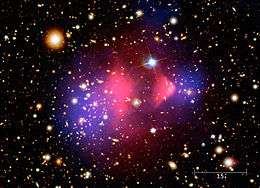Dwarf galaxy problem

The dwarf galaxy problem, also known as the missing satellites problem, arises from numerical cosmological simulations that predict the evolution of the distribution of matter in the universe. Dark matter seems to cluster hierarchically and in ever increasing number counts for smaller-and-smaller-sized halos. However, although there seem to be enough observed normal-sized galaxies to account for this distribution, the number of dwarf galaxies[2] is orders of magnitude lower than expected from simulation.[3][4] For comparison, there were observed to be around 38 dwarf galaxies in the Local Group, and only around 11 orbiting the Milky Way,[2] (for a detailed and more up to date list see List of Milky Way's satellite galaxies) yet one dark matter simulation predicted around 500 Milky Way dwarf satellites.[3][4]
This problem has two potential solutions. One is that the smaller halos do exist but only a few of them end up becoming visible because they have not been able to attract enough baryonic matter to create a visible dwarf galaxy. In support of this, Keck observations in 2007 of eight newly discovered ultra-faint Milky Way dwarf satellites showed that six were around 99.9% dark matter (with a mass-to-light ratio of about 1000).[5] Other solutions may be that dwarf galaxies tend to be merged into or tidally stripped apart by larger galaxies due to complex interactions. This tidal stripping has been part of the problem in identifying dwarf galaxies in the first place, which is an extremely difficult task since these objects have low surface brightness and are highly diffused, so much that they are virtually unnoticeable.
See also
- Dark galaxy
- Cold dark matter
- Cuspy halo problem (also known as "the core/cusp problem")
- List of unsolved problems in physics
References
- ↑ "A galactic nursery". Retrieved 20 July 2015.
- 1 2 Mateo, M. L. (1998). "Dwarf Galaxies of the Local Group". Annual Review of Astronomy and Astrophysics. 36 (1): 435–506. arXiv:astro-ph/9810070
 . Bibcode:1998ARA&A..36..435M. doi:10.1146/annurev.astro.36.1.435.
. Bibcode:1998ARA&A..36..435M. doi:10.1146/annurev.astro.36.1.435. - 1 2 Moore, Ben; Ghigna, Sebastiano; Governato, Fabio; Lake, George; Quinn, Thomas; Stadel, Joachim; Tozzi, Paolo (1999). "Dark Matter Substructure within Galactic Halos". Astrophysical Journal Letters. 524 (1): L19–L22. arXiv:astro-ph/9907411
 . Bibcode:1999ApJ...524L..19M. doi:10.1086/312287.
. Bibcode:1999ApJ...524L..19M. doi:10.1086/312287. - 1 2 Klypin, Anatoly; Kravtsov, Andrey; Valenzuela, Octavio; Prada, Francisco (1999). "Where are the Missing Galactic Satellites?". Astrophysical Journal. 522 (1): 89–92. arXiv:astro-ph/9901240
 . Bibcode:1999ApJ...522...82K. doi:10.1086/307643.
. Bibcode:1999ApJ...522...82K. doi:10.1086/307643. - ↑ Simon, J. D.; Geha, M. (Nov 2007). "The Kinematics of the Ultra-faint Milky Way Satellites: Solving the Missing Satellite Problem". The Astrophysical Journal. 670 (1): 313–331. arXiv:0706.0516
 . Bibcode:2007ApJ...670..313S. doi:10.1086/521816.
. Bibcode:2007ApJ...670..313S. doi:10.1086/521816.
- Bullock (2010). "Notes on the Missing Satellites Problem". arXiv:1009.4505v1
 [astro-ph.CO].
[astro-ph.CO].
External links
- The End of Small Galaxies (SPACE.com) 22 May 2006 06:12 am ET
